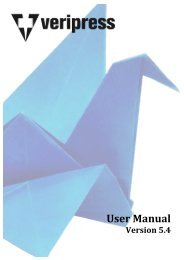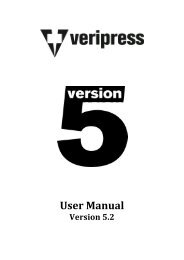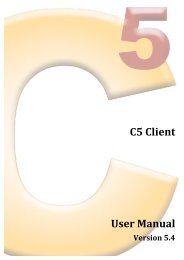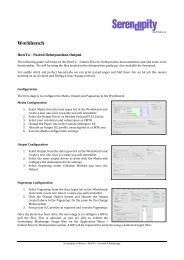Version 5.3.02 - Serendipity Software
Version 5.3.02 - Serendipity Software
Version 5.3.02 - Serendipity Software
Create successful ePaper yourself
Turn your PDF publications into a flip-book with our unique Google optimized e-Paper software.
Camera <br />
The Camera data type is used to define an RGB (or Camera) ICC profile colourspace for use when viewing RGB <br />
images in the SoftProof application. Users can configure whether the default Camera profile or image embedded ICC <br />
profile is automatically selected and applied to an RGB image when opened in SoftProof. See Applications > SoftProof > <br />
SoftProof Settings for further details. <br />
Colour Management <br />
• Camera ICC Profile – Select the ICC profile to assign. <br />
• Rendering Intent – Select the rendering intent to be used. <br />
• Black Point Compensation – Enable/Disable Black Point <br />
Compensation. <br />
• Calcheck Chart – Assign a Calcheck Chart for Camera colour verification checks using the Displays application. <br />
DotGain Curve <br />
A DotGain Curve can be used to compensate for or represent dot gain on the final output. In this section, <br />
curves can be created for application to a Pagesetup in order to change the output. <br />
The curve may be applied for two (2) reasons: <br />
• After the initial calibration you may find that the resultant output is either slightly <br />
too dark or slightly too light. A DotGain Curve can be applied to the process or <br />
specials (or both) to make the print lighter or darker; or <br />
• To represent a press or printing process dot gain on the proof. <br />
Toolbar Options <br />
• Trace Saved Curve – A green line appears, showing where the curve was last saved <br />
to see where the curve has been edited. <br />
• Invert Curve – Invert the selected curve. An inverted curve can be used to compensate for the colour <br />
characterisation or platesetter dotgain curves output by a platesetter RIP, returning jobs to a linear state for <br />
proofing. <br />
• Dotgain Table – Enter values manually to adjust or create a curve. <br />
• Import from CSV – Import values from a CSV file. The file must contain exactly 23 values for each colour as <br />
defined in the Dotgain table editor. <br />
Note: The Process and Special DotGain curves only apply to CMYK input jobs. RGB jobs will not be affected. <br />
Gradation Curve <br />
A Gradation Curve is used to adjust colour in a job by applying a curve to the individual process colours. The <br />
Gradation Curve can be applied to a Media either as a Linearisation Curve or <br />
as a Correction Curve. A Linearisation Curve is normally applied as part of the <br />
early calibration stage and this is recommended. A Correction Curve is applied <br />
if a small amount of fine-‐tuning is required after normal calibration <br />
procedures. <br />
Toolbar Options <br />
• Trace Saved Curve – A green line appears, showing where the curve <br />
was last saved to see where the curve has been edited. <br />
• Invert Curve – Inverts the selected curve. <br />
• Gradation Table – Enter values manually to adjust or create a curve. <br />
• Preview Curves – Displays a window with all curves in their respective colours to assess them in relation to <br />
each other. This is updated dynamically as changes are made. <br />
• Lineariser – Loads a Linearisation Curve directly into the Lineariser application. <br />
<strong>Serendipity</strong> <strong>Software</strong> -‐ Veripress User Manual – <strong>Version</strong> <strong>5.3.02</strong> <br />
31












